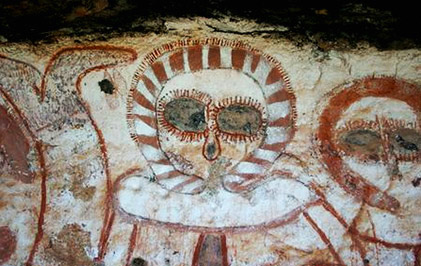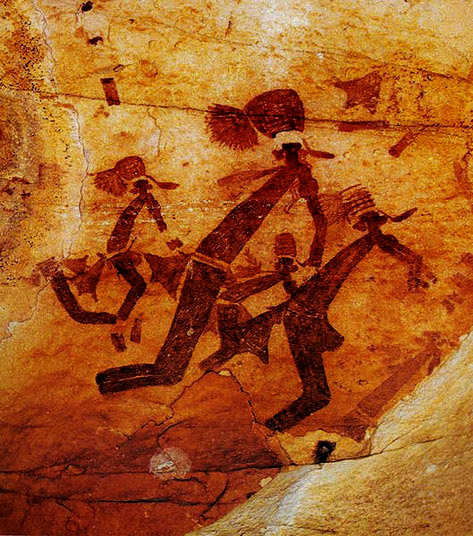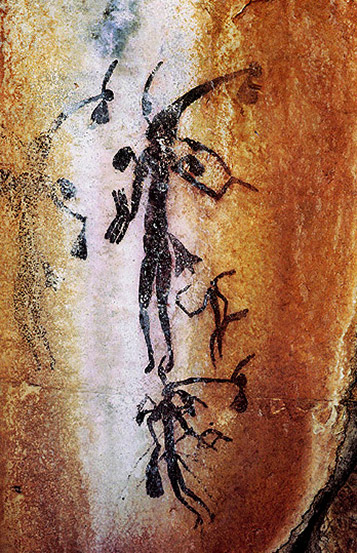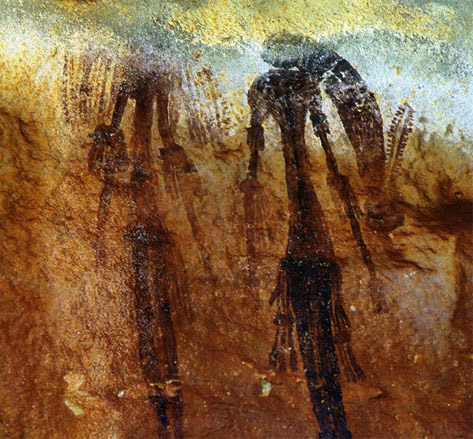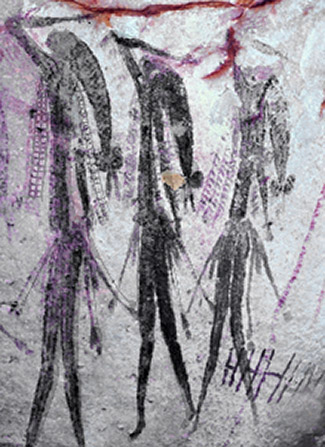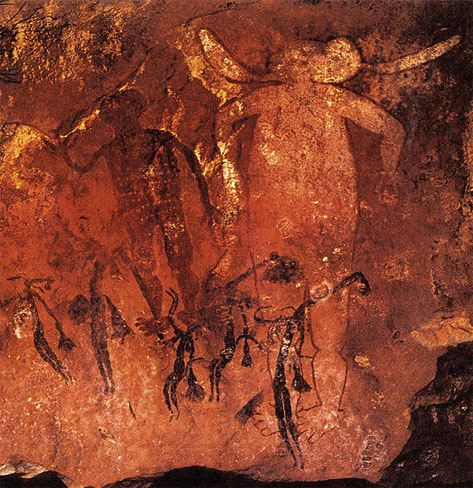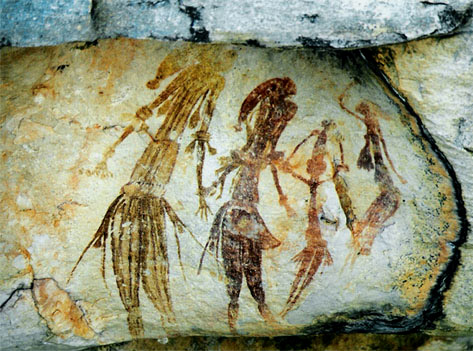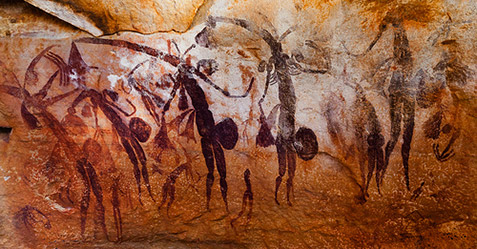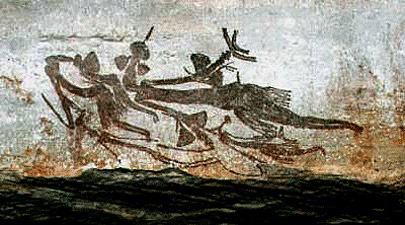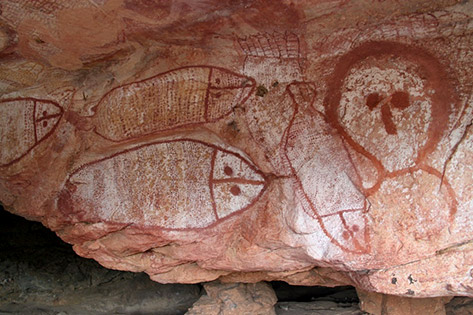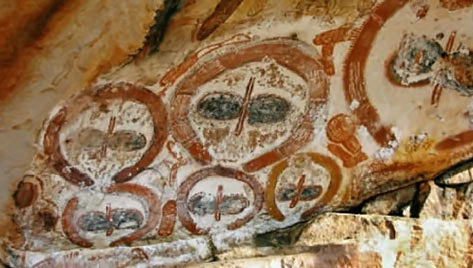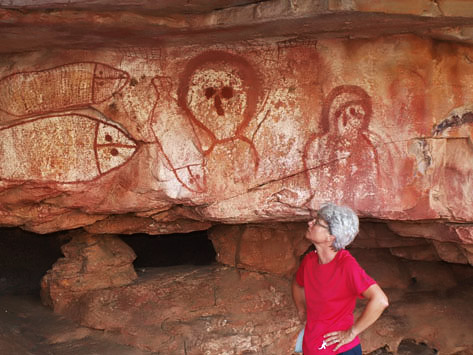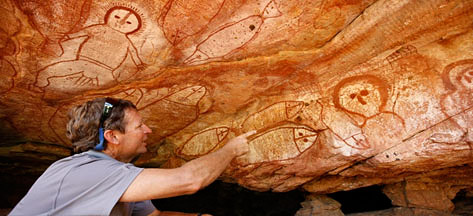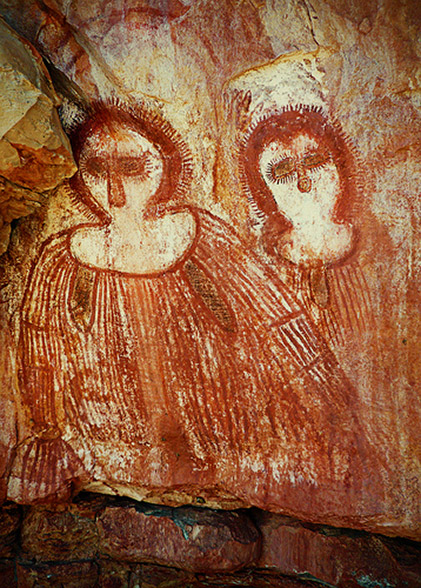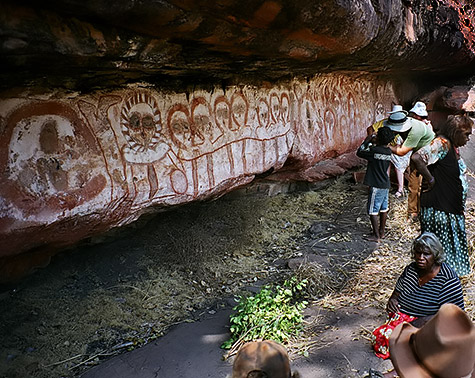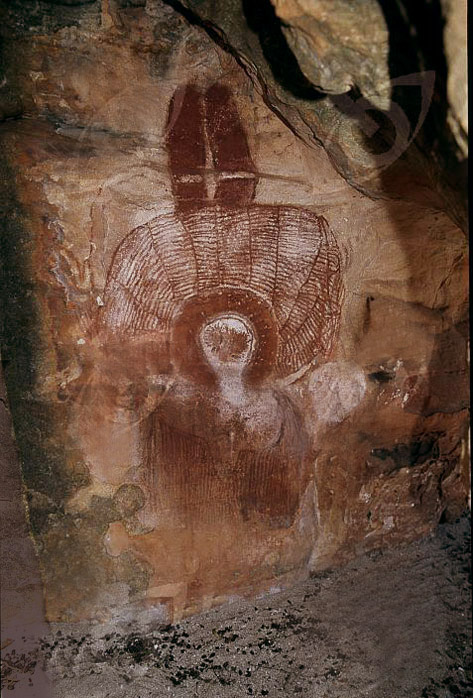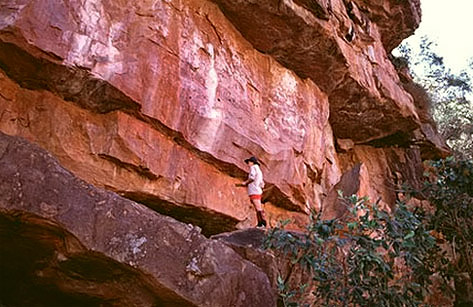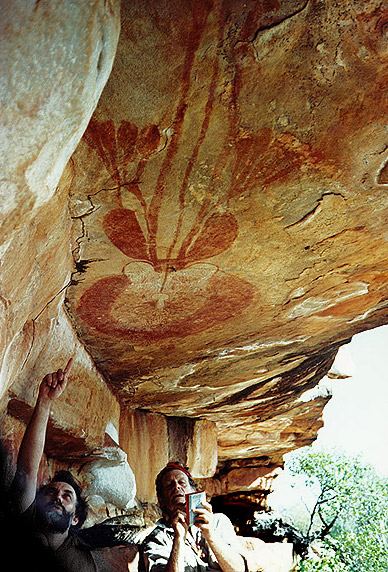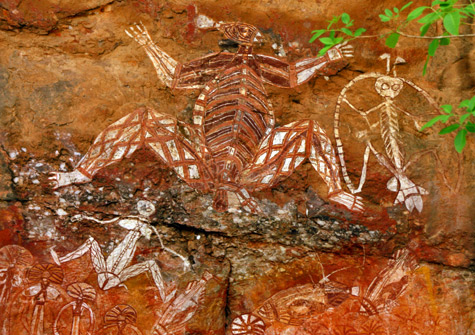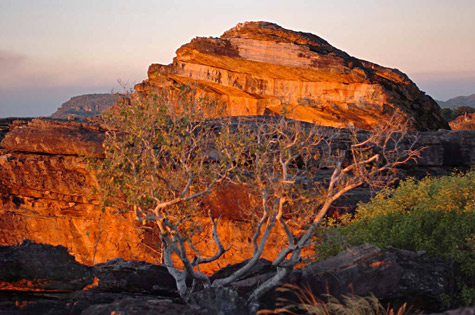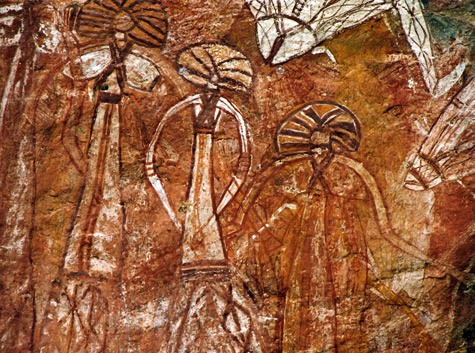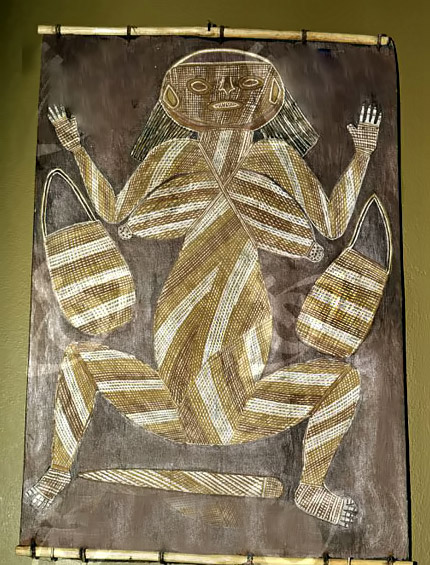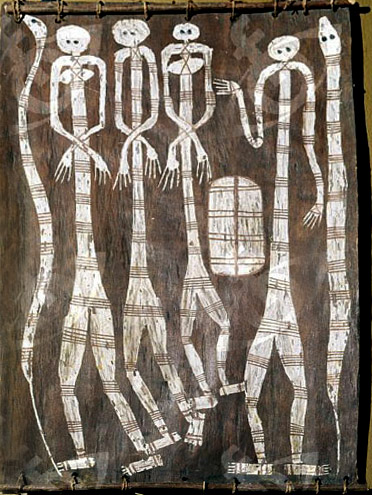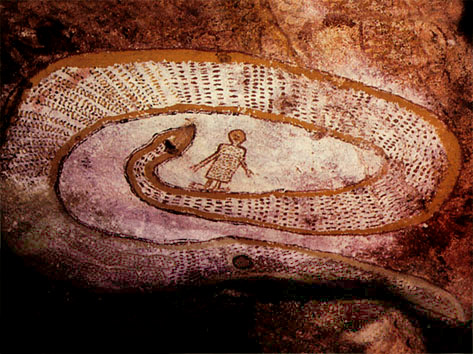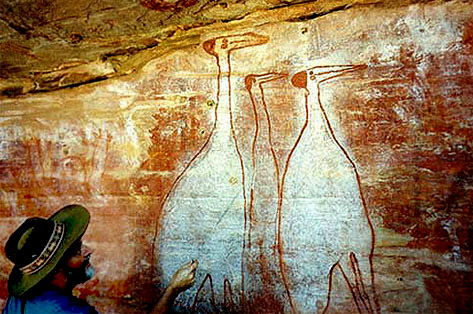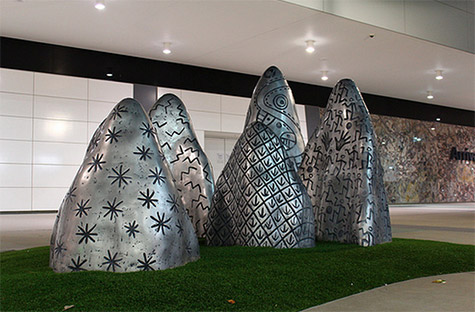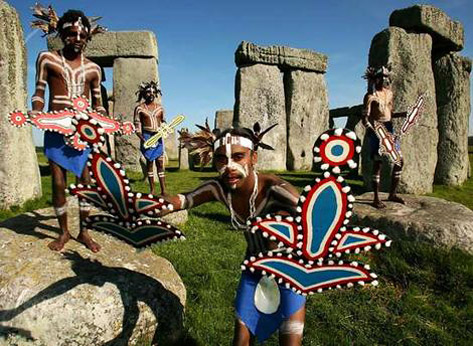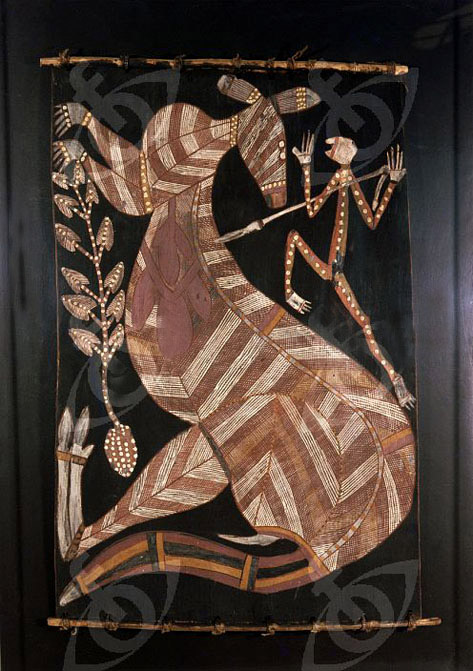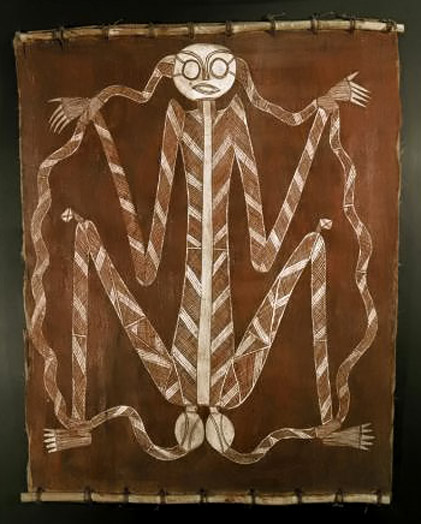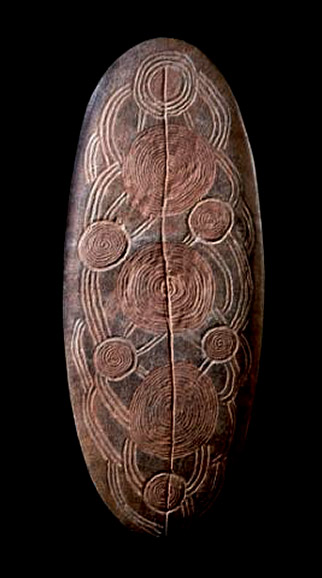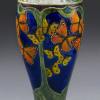Wandjina rock painting – ( Kimberley Foundation )
…
Aboriginal rock paintings in the Kimberley
Bradshaw/ Gwion Gwion
The Kimberley mountain ranges stretch across the northern tip of Western Australia. Joseph Bradshaw, an English pastoralist found the original rock art sites in 1891 on the Roe River in the north-west Kimberley. They became known as the Bradshaws, but currently the figures are more commonly known by their local Aboriginal name Gwion Gwion or Gwion, a name derived from one of the Aboriginal beliefs in the Kimberley that explains their origins. The Bradshaws are significant to world history because instead of depicting animals, they use humans as the primary subject. The use of humans as subjects is very rare for paleolithic art. This mysterious form of rock art could legitimately be referred to as one of the seven wonders of the ancient world.
Ancient Bradshaw cave art paintings
( Bradshaw Foundation )
The late Graham Walsh, documented and studied the art for over 40 years. The combination of the pictures themselves and the oral history of the local tribes led Walsh to conclude that they were painted by an unknown Asiatic race before the last ice age. Walsh also concluded that they were a form of iconography. Walsh based his conclusions on the fact that the paintings showed no signs of development and simply appeared in their most advanced form.
It is an Aboriginal understanding that the fauna and flora of the landscape possess an ‘increase centre’ or an area of high electro-magnetic energy where the performance of correct rituals will increase the life essence or Kurunba stored. The natives know that it is not the actual paintings in the caves that activate the Kurunba but the rocks on which they are drawn; the rocks being imbued with the ‘spirit’ of the entities depicted. Sacred works of art such as the Wandjina act as powerful images, capable of stimulating and intensifying mind power during rituals, similar in nature to Vantras or designs used in Tantric meditative techniques. Bradshaw/Gwion rock art is best recognised from the depiction of graceful, active, long-bodied humans, often of a mulberry hue with tassels, hair adornments, and possibly clothing .
Bradshaw rock art figures
( Bradshaw Foundation )
Bradshaw rock art in the Kimberleys
( photo – Hugh Brown )
Bradshaw Tassel figures
( Kimberley foundation )
Gwion rock painting at King Edward River
Bradshaw/Gwion rock paintings
( Chris O’Connel photo )
Bradshaw rock art – Graham Ezzy – flickr
Bradshaw Art of the Kimberley
Wandjina
Here, in some distant age, mysterious enigmatic images of mouthless beings, some clad in robes and surrounded by what appears to be a halo, were inscribed on the rock faces of numerous caves. Sacred to the Aboriginal of the Kimberleys, the images are revered as awesome beings who in primeval times, wandered around the landscape, instructing the indigenous people in the use of weapons and tools and initiating the tribal laws, rites and customs, and after completing their task they disappeared into the heavens or into the ground. They called themselves Wandjina, sometimes spelled Wondjina.
Wandjinas, the other rock art style for which the Kimberley has long been famous, were first recorded by the explorer George Grey in the Kimberley in 1837 . These Wandjina sites are found in the Glenelg River area.
At least 4,000 years old, it is a living art form representing ancestral beings originating in the sea and the sky. Images of Wandjina are characterised by halo-like headdresses and mouthless faces with large round eyes, fringed with eyelashes, set either side of an ovate nose
The large scale, and solid or static appearance of the Wandjina art contrasts with the Bradshaw/ Gwion art, with its more delicate images of a usually smaller scale, and its less tangible connection with contemporary indigenous culture.
Bigge Island rock art – Kimberley WA
Kimberly rock art painting – Wandjina
Wandjina rock-art at Raft Point in the Kimberley
Raft Point Wandjina rock art
Wandjina rock art, Australia
( Stevo850 Flickr )
The Aboriginal people always drew only what they saw. They never expressed any creativity or fantasy in the rock paintings.
They believed the Wandjina’s are the originators of all human customs, and the inventor of all implements.
Aboriginal cave painting of a Wandjina
Moran River 2002
( bradshaw foundation )
Graham Walsh and Robert Hefner III
( bradshaw foundation )
Narwala Gabarnmang is covered on its ceiling and pillars with rock art, and only accessible by a 90 minute helicopter journey from the outback town of Katherine. Researchers consider the site one of the most extensive rock art sites in the world, described as the ‘Sistine Chapel’ of Australian rock art sites.
Ubirr, Nourlangie Rock and Nanguluwur are outstanding examples of Aboriginal rock art
Ubirr, Kakadu, Northern Territory
Kakadu rock art
Corroboree dance with String Cross
( bradshaw foundation )
Edward Blitner ?
Bark painting from western Arnhem-land depicting a woman with two dilly bags and a digging stick. The design was probably associated with ceremonies to increase fertility.
( Scala Archives )
Bark painting depicting two pairs of male and female figures, possibly spirit beings, with two snakes
Wandjina Serpent rock painting
Grahame Walsh views a painting of Cranes
( bradshaw foundation )
Mysterious Mountains – late Tapich Gloria Fletcher ( Thanakupi ), an Indigenous ceramicist and sculptor born in the remote Aboriginal community of Napranum, near the tip of Cape York Peninsula.
( Cairns Airport )
see more from a post on Thanakupi here
Bardi dancers from Western Australia at Stonehenge, the first Aboriginal dance group to stage a performance there.
Photo: Julian Andrews
Bark painting in X-ray style depicting a kangaroo and a hunter. The specific form of cross hatching served to associate paintings with individual clans and to endow the objects painted with spiritual force.
( Werner Forman Archive )
Bark painting from western ArnhemLand, depicting a legendary ‘Lightning Man’ or Wala-Undayna, one of the super-natural beings of the Dreamtime.
( Werner Forman Archive )
Churinga. It was believed that the ancestors of the Dreamtime and their weapons had become these sacred discs.They represent each person’s immortal spirit, while the design is a totemic pattern of the associated sacred site.
( Werner Forman Archive )
The Wandjina weren’t depicted with mouths because they never spoke, they only communicated telepathically, according to ancient beliefs.

